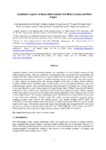Por favor, use este identificador para citar o enlazar este ítem:
http://www.alice.cnptia.embrapa.br/alice/handle/doc/1034781Registro completo de metadatos
| Campo DC | Valor | Lengua/Idioma |
|---|---|---|
| dc.contributor.author | OLIVEIRA, A. R. de | pt_BR |
| dc.contributor.author | JACINTO, M. A. C. | pt_BR |
| dc.contributor.author | FUCK, W. F. | pt_BR |
| dc.contributor.author | GRASEL, F. dos S. | pt_BR |
| dc.contributor.author | FACÓ, O. | pt_BR |
| dc.contributor.author | SHIOTSUKI, L. | pt_BR |
| dc.contributor.author | ESTEVES, S. N. | pt_BR |
| dc.date.accessioned | 2016-01-22T11:11:11Z | pt_BR |
| dc.date.available | 2016-01-22T11:11:11Z | pt_BR |
| dc.date.created | 2016-01-22 | pt_BR |
| dc.date.issued | 2015 | pt_BR |
| dc.identifier.citation | In: CONGRESSO INTERNATIONAL UNION OF LEATHER TECHNOLOGISTS AND CHEMISTS SOCIETS, 33., 2015, Novo Hamburgo. Anais... Novo Hamburgo: ABQTIC, 2015. | pt_BR |
| dc.identifier.uri | http://www.alice.cnptia.embrapa.br/alice/handle/doc/1034781 | pt_BR |
| dc.description | Vegetable tannins, used by the tanning industry, are considered to be eco-friendly because of their natural tanning agents. They are composed of polyphenols and are divided into hydrolysable and condensed tannins. Hydrolysable tannins are glucose polyesters classified into gallic or ellagic tannins. Condensed tannins, however, consist of catechin monomers, known as flavonoids. The native sources of plant extracts for tanning hides, the tanning potential of the barks of Black Jurema (Mimosa tenuiflora [Willd.] Poir.) and Red Angico (Anadenanthera macrocarpa [Benth.] Brenan.) trees were evaluated; these species were collected from the semi-arid region of Morada Nova, in the state of Ceará, and from the cerrado biome region of Campo Grande, state of Mato Grosso do Sul (Brazil), respectively. These extracts were characterized and classified as condensed tannins. When compared to the black wattle (Acacia mearnsii De Wild), these tannins presented a lower extraction yield as well as lower light fastness. The tanning methodology used in the Morada Nova sheep hides was the same as that used in the evaluation of black wattle. The leather was not re-tanned or greased, and no auxiliary products were used in the tanning process. The tensile strength (ABNT NBR ISO 3376:2014) of the leather tanned with Jurema does not differ significantly (P>0.05) from the leather tanned with Angico. The leather tanned with Angico showed higher tear strength (P<0.05) in the tests performed according to the procedures defined in the ABNT NBR ISO 3377-1 (2014) and 3377-2 (2014) guidelines. It also presented higher shrink resistance (ABNT NBR 13335:2001). | eng |
| dc.language.iso | eng | pt_BR |
| dc.rights | openAccess | pt_BR |
| dc.subject | Black Jurema | pt_BR |
| dc.subject | Red Angico | pt_BR |
| dc.subject | Vegetable tannins | pt_BR |
| dc.subject | Sheep hides | pt_BR |
| dc.title | Qualitative aspects of sheep hides tanned with Black Jurema and Red Angico. | pt_BR |
| dc.type | Artigo em anais e proceedings | pt_BR |
| dc.date.updated | 2016-01-22T11:11:11Z | pt_BR |
| riaa.ainfo.id | 1034781 | pt_BR |
| riaa.ainfo.lastupdate | 2016-01-22 | pt_BR |
| dc.contributor.institution | ALEXANDRA ROCHA DE OLIVEIRA, CNPGC; MANUEL ANTONIO CHAGAS JACINTO, CPPSE; WAGNER FERNANDO FUCK, TANAC S. A./MONTENEGRO - RS; FABIO DOS SANTOS GRASEL, TANAC S.A./MONTENEGRO - RS; OLIVARDO FACÓ, CONSERVATION AND ANIMAL GENETIC IMPROVEMENT/ SOBRAL; LUCIANA SHIOTSUKI, CONSERVATION AND ANIMAL GENETIC IMPROVEMENT/SOBRAL; SERGIO NOVITA ESTEVES, CPPSE. | pt_BR |
| Aparece en las colecciones: | Artigo em anais de congresso (CPPSE)  | |
Ficheros en este ítem:
| Fichero | Descripción | Tamaño | Formato | |
|---|---|---|---|---|
| Papertaninosen1.pdf | 1,56 MB | Adobe PDF |  Visualizar/Abrir |









